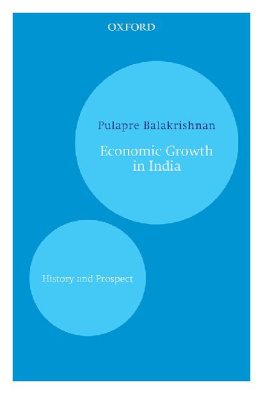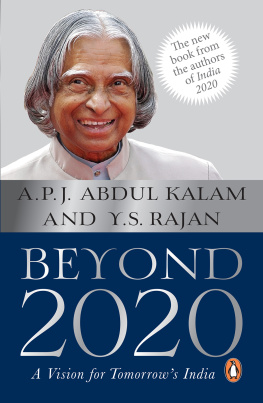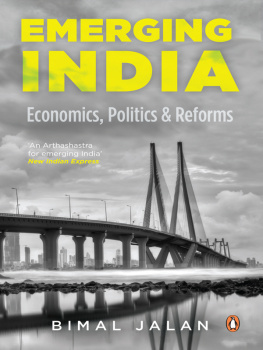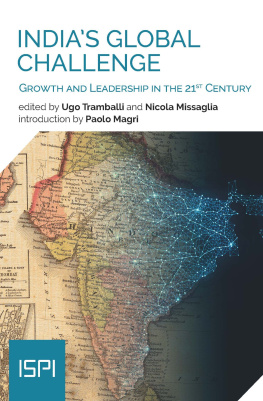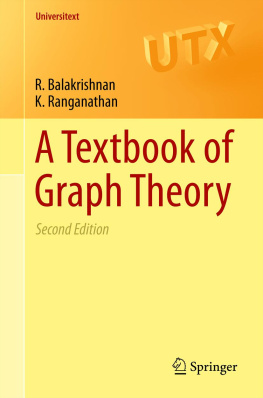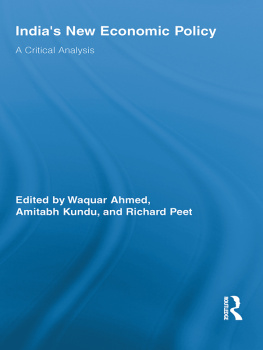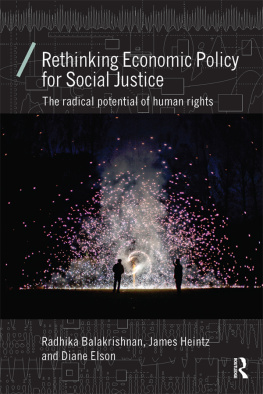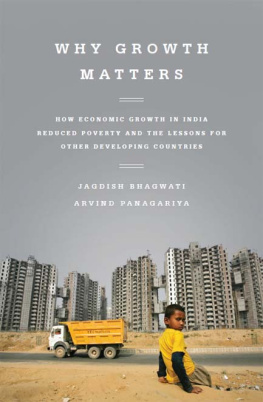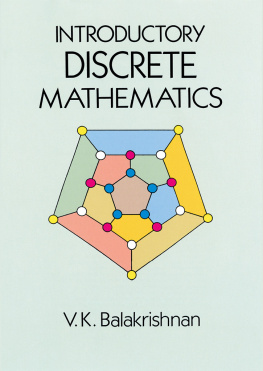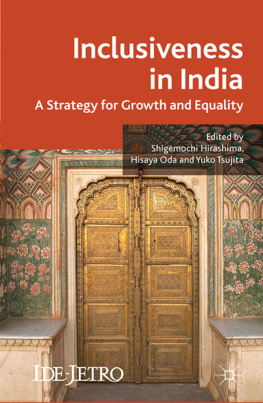ECONOMIC GROWTH IN INDIA
Economic Growth in India
History and Prospect
PULAPRE BALAKRISHNAN
YMCA Library Building, Jai Singh Road, New Delhi 110 001
Oxford University Press is a department of the University of Oxford. It furthers the
University's objective of excellence in research, scholarship, and education
by publishing worldwide in
Oxford New York
Auckland Cape Town Dar es Salaam Hong Kong Karachi Kuala Lumpur
Madrid Melbourne Mexico City Nairobi New Delhi Shanghai Taipei Toronto
With offices in
Argentina Austria Brazil Chile Czech Republic France Greece Guatemala
Hungary Italy Japan Poland Portugal Singapore South Korea Switzerland
Thailand Turkey Ukraine Vietnam
Oxford is a registered trademark of Oxford University Press
in the UK and in certain other countries
Published in India
by Oxford University Press, New Delhi
Oxford University Press 2010
The moral rights of the author have been asserted
Database right Oxford University Press (maker)
First published 2010
Fifth impression 2011
All rights reserved. No part of this publication may be reproduced,
or transmitted in any form or by any means, electronic or mechanical,
including photocopying, recording or by any information storage and
retrieval system, without permission in writing from Oxford University Press.
Enquiries concerning reproduction outside the scope of the above should be
sent to the Rights Department, Oxford University Press, at the address above
You must not circulate this book in any other binding or cover
and you must impose this same condition on any acquirer
ePub ISBN-13: 978-0-19-908817-1
ePub ISBN-10: 0-19-908817-9
Typeset in Minion Pro 10/12.6
by Sai Graphic Design, New Delhi - 110 055
Printed in India at Anvi Composers, New Delhi 110 036
Published by Oxford University Press
YMCA Library Building, Jai Singh Road, New Delhi 110 001
For Sivakami and Balakrishna Menon
who started me off ,
and to the peasants and workers of India
who quickened her economy
Contents
One of the greatest benefits of supervising graduate students is to be able to follow their subsequent careers and see them realize their potential. Pulapre Balakrishnan (Bala) was one of my PhD students at Cambridge in the 1980s. He wrote a fine dissertation on pricing and inflation in India. It was characterized by excellent understanding of the relevant theory, suitable adaption to the Indian case, and sensible use of econometric procedures to test the inferences drawn from the theoretical structure. He exhibited the traits of an excellent all-round economist. In his new book, Economic Growth in India: History and Prospect , all these traits are present in their full maturity.
The book is a comprehensive study of growth in post-Independence India. The theory is both subtle and eclectic, drawing on several strands of the relevant literature, and presented in an original narrative by the author. It uses empirical methods to advantage and in the process of examining the several sensibly-defined historical periods, the author tests whether the conventional wisdom on these stands up to close scrutiny. If it does not, he explains why, and also why his carefully presented narrative is a more convincing explanation. In setting out the history of the various phases of growth, Bala is careful to praise the positive aspects, while pointing out clearly and fairly the deficiencies and shortcomings. Most of all, his humane approach always leads him to evaluate how the less well-off have fared and, if they have not gained from the growth in India, as is often the case, what should be done about it.
While reading Bala's new book, I have also been reading the three volumes of the late A.K. Dasgupta's Collected Works (New Delhi, Oxford University Press, 2009). I was struck by the similarity of their approaches, both in setting out economic theory and applying it. Their findings are explained in clear distinguished prose, bringing out the economic intuition of their analysis while unobtrusively, but clearly, supplying the necessary technical back-up to their results. Bala's book is a major contribution, which is destined to have a proper impact on the profession's understanding of recent Indian economic history and on what may be learned from it.
It is a privilege to write the foreword to this excellent book and to be able to pay a tribute to a former student and a firm friend.
G.C. H ARCOURT
Jesus College
University of Cambridge
This work was fully funded by a Senior Fellowship of the Nehru Memorial Museum and Library (NMML), New Delhi. Therefore, the first and largest part of the gratitude that I would like to express for the support that I have received in completing it goes to this unique national foundation. Its lavish award alone afforded me the leisure so central to such an undertaking. Apart from funding my research, the Library also waived for me its mandatory residence requirement, allowing me to remain at Kozhikode, which has considerably furthered my research and writing. This special dispensation was due to the high-mindedness of K. Jayakumar and N. Balakrishnan, the Acting Director and Deputy Director, respectively, at the time of my assuming the Fellowship in March 2006. The understanding was magnanimously maintained by Mridula Mukherjee who was to take over as the full-time Director a little later. Since for the economist, material outcomes can never be wished away, I am relieved to note that their judgement paid for itself in the form of this book! Subsequently at the NMML, P. Chandramohan, Deepa Bhatnagar, Aruna Tandan, and the staff of the Library and the Administration all facilitated my research in various ways.
A study as wide-ranging as this could not have been accomplished without the assistance of many individuals, and it gives me great pleasure to acknowledge their inputs. Foremost among them are M. Parameswaran and M. Suresh Babu. Parameswaran generously agreed to my use in this book of our joint work and updated the statistical exercises as more data and better methods became available. Suresh Babu read the entire manuscript, suggested how my arguments could be improved, chased up the data needed to support them, and assisted with the graphics. These two young economists exhibit an understanding of the economy and a sense for the right methodology in applied work that far exceed their years in the profession. I have been the beneficiary of these rare capabilities.
Among the persons with whom I have had the privilege of discussing my ideas as they appear here are Bharat Ramaswami, Arunava Sen, Aditya Bhattacharjea, Amitava Bose, Balaram Menon, Venugopal Menon, K. Pushpangadan, E. Sridharan, Rajagopal Natarajan, D.J. Bangara, C. Selvaraj, Jairam Ramesh, Murkoth Ramunni, Ramachandra Guha, Francine Frankel, Ruchira and Ajit Kumar Ghose, Ravi Arvind Palat, V.N. and Ahalya Balasubramanyan, Govinda Rao, S.K. Rao, Abhijit Manik Sen, Ashok Soota, K.P. Sankaran, K. Saradamoni, Arunima Gopinath, Prem Shankar Jha, Majid Siddiqui, Partha Dutta, R. Nagaraj, Mahesh Rangarajan, Dilip Mookherjee, Amrit Tandon, Debraj Ray, Mukesh Eswaran, Sushil Kumar Pillai, K.C. Mohan, Ashok Kotwal, T.N. Srinivasan, Aditya and Mridula Mukherjee, Tirthankar Roy, N.R. Nanda Kishore, Surajit Das, Anit Mukherjee, K.R.S. Murthy, N. Chandramohan, M.P. Chandrashekaran, Sanjaya Baru, Rakesh Mohan, the late Amaresh Bagchi, C.T. Kurien, K.L. Krishna, A.R. Vasavi, Preeti Bahadur, Jayati Ghosh, Tapas Sen, V.R. Panchamukhi, Deb Kusum Das, Abdul Azeez, N.J. Kurien, Peter de Souza, Ram Manohar Reddy, Vijay Shankar, V.K. Natraj, P.V. Shenoy, Rajeswari and Dhruv Raina, Ajit Mozoomdar, Shovan Ray, Prakash Upadhyaya, R. Govinda, Guilherme Vaz, S. Venkitaramanan, Manmohan Agarwal, Gurbachan Singh and Ritesh Jain. All of them have been generous with their time and advice even when they have disagreed with me, at times strongly. Finally, the comments and suggestions of two anonymous referees have improved the argument and the structure of the book. Of course, I remain responsible for the views expressed here.



